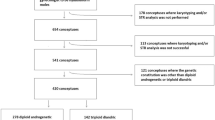Summary
In the course of a systematic study of cytogenetics, morphology, and clinical follow-up of hydatidiform moles we encountered two unusual cases of partial hydatidiform moles each with a 92,XXXY karyotype. Previously reported cases of tetraploidy, of 92,XXXX or 92,XXXY karyotype, resulted from a failure of the first mitotic division of a normal zygote. This is to our knowledge the first report of tetraploidy with XXXY sex chromosomes. Study of chromosomal heteromorphisms, isozymes, and restriction fragment length polymorphisms reveal that both present cases resulted from a combination of a haploid ovum with three haploid sets of paternal chromosomes either by the mechanism of trispermy (involving three separate haploid spermatozoa) or through dispermy (involving one haploid and one diploid sperm). Both cases resembled closely partial moles in their morphology; one gave a highly typical clinical picture while the other was recognized at an early voluntary abortion. Partial moles are ordinarily triploids of nearly always diandric constitution that evince focal villous swelling with cistern formation and focal trophoblastic hyperplasia. The findings here presented point to an association of molar phenotype with an excess of paternal over maternal haploid sets.
Similar content being viewed by others
References
Barker D, Schafer M, White R (1984) Restriction sites containing CpG show a higher frequency of polymorphism in human DNA. Cell 36:131–138
Barton SC, Surani MAH, Norris ML (1984) Role of paternal and maternal genomes in mouse development. Nature 311:374–376
Boue JG, Boue A (1976) Chromosomal anomalies in early spontaneous abortion. In: Gropp A, Benirschke K (eds) Developmental biology and pathology. Springer, Berlin Heidelberg New York, pp 193–208 (Current topics in pathology, vol 62)
Golbus MS, Bachman R, Wiltse S, Hall BD (1976) Tetraploidy in a liveborn infant. J Med Genet 13:329–332
Jacobs PA, Szulman AE, Funkhouser J, Matsuura JS, Wislon CC (1982) Human triploidy: relationship between, parental origin of the additional haploid complement and development of partial hydatidiform mole. Ann Hum Genet 46:223–231
Kajii T, Niikawa N (1977) Origin of triploidy and tetraploidy in man: 11 cases with chromosome markers. Cytogenet Cell Genet 18:109–125
Kelly TE, Rary JM (1974) Mosaic tetraploidy in a two-year-old female. Clin Genet 6:221–224
McGrath J, Solter D (1984) Completion of mouse embryogenesis requires both maternal and paternal genomes. Cell 137:179–183
O'Brien S, Shannon J, Gail M (1979) A, molecular approach to the identification and individualization of human and animal cells in culture: isozyme and allozyme genetic signatures. In Vitro 16:119
Pitt D, Leversha M, Sinfield C, Campbell P, Anderson R, Bryan D, Rogers J (1981) Tetraploidy in a liveborn infant with spina bifida and other anomalies. J Med Genet 18:309–311
Scarbrough PR, Wilderson S, Carrol AJ, Hersh JH, Finley SC, Yen FF (1983) Tetraploidy in two liveborn infants. Am J Hum Gen 35:152A (abstr)
Sheppard DM, Fisher RA, Lawler SD, Povey S (1982) Tetraploid conceptus with three paternal contributions. Hum Genet 62:371–374
Smith E, Szulman AE, Hinshaw W, Tyrey L, Surti U, Hammond CB (1984) Human chorionic gonadotropin in benign gestational trophoblastic disease: characteristics of partial hydatiform moles. Am J Obstet Gynecol 149:129–132
Surani MAH, Barton S (1983) Development of gynogenetic eggs in the mouse: implications for parthenogenetic embryos. Science 222:1034–1036
Surani MAH, Barton SC, Norris ML (1984) Development of reconstituted mouse eggs suggests imprinting of the genome during gametogenesis. Nature 308:548–550
Surti U, Szulman AE, O'Brien S (1979) Complete (classic) hydatidiform mole with 46,XY karyotype of paternal origin. Hum Genet 51:153–155
Surti U, Szulman AE, O'Brien S (1982) Dispermic origin and clinical outcome of three complete hydatidiform moles with 46,XY karyotype. Am J Obstet Gynecol 144:84–87
Szulman AE, Surti U (1982) Clinico-pathological profile of partial hydatidiform mole. Obstet Gynecol 59:597–602
Szulman AE, Phillipe E, Boue J, Boue A (1981) Human triploidy: association with partial hydatidiform moles and nonmolar conceptuses. Hum Pathol 12:1016–1021
Wagener DK, Surti U, Szulman AE (1983) A simple genetic model for the complete and partial hydatidiform moles. Am J Hum Genet 35:72A (abstr)
Author information
Authors and Affiliations
Rights and permissions
About this article
Cite this article
Surti, U., Szulman, A.E., Wagner, K. et al. Tetraploid partial hydatidiform moles: two cases with a triple paternal contribution and a 92,XXXY karyotype. Hum Genet 72, 15–21 (1986). https://doi.org/10.1007/BF00278810
Received:
Revised:
Issue Date:
DOI: https://doi.org/10.1007/BF00278810




